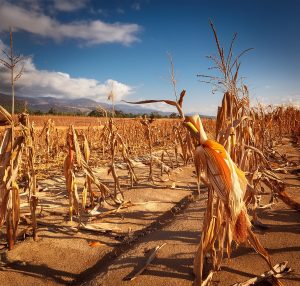

IN the heart of Lupane, Matabeleland North, western Zimbabwe, lives Nomater Dube, a small-scale farmer, who upon gazing at her barren fields, recalls the lush green paradise of maize plants it used to be in a typical planting season. But now, the reality in front of her is far from the thriving crops she used to know.
With hopelessness in her voice, Dube shares how her maize crops – which should have been teeming with life at this time of the year – refuse to sprout due to relentless dry spells.
“This time, the little maize we planted hasn’t come out due to the dry spells. As farmers, we bear the brunt of climate change,” the 35-year-old said.
The agricultural sector in Zimbabwe has been hard hit by climate change, exacerbating the need for the operationalisation of the loss and damage fund to help farmers cope with crop failure, prolonged heatwaves and livestock deaths.
COP28, which begins this week, will present a platform for Zimbabwe to advocate for climate financing for backing up, bouncing back, resilience building and rehabilitation, including livelihood recoveries.
The loss and damage fund, established during COP27, aims to provide financial assistance to nations most vulnerable and impacted by the effects of climate change.
As a climate change induced drought looms over Zimbabwe, the Lupane region has experienced a disastrous mix of erratic rainfall, flash floods and long dry spells causing Dube as well as other farmers to suffer profound impacts on their livelihood.

The agricultural sector in Zimbabwe has been hard hit by climate change, exacerbating the need for the operationalisation of the loss and damage fund to help farmers cope with crop failure, prolonged heatwaves and livestock deaths.
But Dube’s plight is not isolated; it echoes the sentiments of approximately 80% of Zimbabwe’s rural population, dependent on rain-fed agriculture for their livelihoods. The reliance on nature’s whims makes them highly susceptible to the intensifying impacts of extreme weather events, such as droughts.
El Niño-induced drought
As Zimbabwe braces itself for the 2023/24 rainfall season, meteorological forecasts paint a grim picture, predicting normal to below-normal rainfall – a direct consequence of the El Niño phenomenon.
El Niño, which amplifies extreme weather events, is a cycle of warming and cooling events that happens along the equator in the Pacific Ocean leading to an increase in sea surface temperatures across the Pacific.
The implications are profound, with the agricultural sector poised for yet another challenge that threatens the food security and economic stability of the nation.
In the face of this impending crisis, the urgency to operationalise the loss and damage fund at COP28 becomes undeniable. The struggle of farmers like Dube highlights the need for comprehensive support mechanisms that extend beyond traditional agricultural assistance.
Climate change communicator, Peter Makwanya, says this year’s El Niño expected to be unusual and unique.
“The El Niño factor will have main impact on the crop yields, resulting into loss of crops through intense and widespread heat, losses in farming inputs, livestock and a large impact on the moisture and surface to underground water levels. While some regions of Zimbabwe will experience less rainfall, other regions would experience large scale flooding which would also culminate in wide scale destruction of crops, property, buildings and infrastructure,” Makwanya said.
According to the Zimbabwe Vulnerability Assessment Committee rural 2023 report, an estimated 26 percent of households, equivalent to 2.7 million people, may face food insecurity by January to March 2024.
Zim government to push for climate justice
Zimbabwe negotiators look to amplify their voices at COP28 regarding the loss and damage fund for the southern African nation to benefit.
The loss and damage fund seeks to assist developing nations especially those vulnerable to recover from the loss and damage caused by climate change.
Director for the Climate Change Management Department in the Ministry of Environment and Climate, Washington Zhakata, says the loss and damage fund will be critical for Zimbabwe considering that it is now highly vulnerable to the impacts of climate change.
“The fund will be useful for the country to move forward because the fiscus is overconstrained,” Zhakata, who is also the UN Framework for Climate Change Convention focus person for Zimbabwe, said.
He is, however, worried about the accessibility of the fund for countries like Zimbabwe.
“We stand ready to go and fight for the fund to be open to not only the least developed countries and small island developing states but also to countries like Zimbabwe that are developing and have been impacted by climate change,” Zhakata said.
On his part, Daniel Sithole, a climate expert, said the loss and damage fund could help Zimbabwe recover from climate shocks and build resilience for the future.
“For countries like Zimbabwe, which are highly vulnerable to climate change and have low emissions, the loss and damage fund could be a source of support and justice,” Sithole said.
“The fund could enable Zimbabwe to access technical and financial resources to implement measures such as disaster risk reduction, early warning systems, social protection, climate-smart agriculture, and ecosystem restoration,” he added.
Climate funding gap
According to the African Development Bank, Zimbabwe has a climate-financing gap of about US$500 million annually, which has impacted its ability to build climate resilience.
In 2009, developed countries promised that from 2020 they would transfer US$100 billion a year to poorer nations hit by worsening climate change-fuelled disasters but it has not been realised.
At the UN climate summit, food, agriculture and water will feature in the two-week schedule. Dube and several rural farmers in Zimbabwe’s future depend on the discussions on the loss and damage fund, particularly how they will recover from widespread crop loss and livestock fatalities.